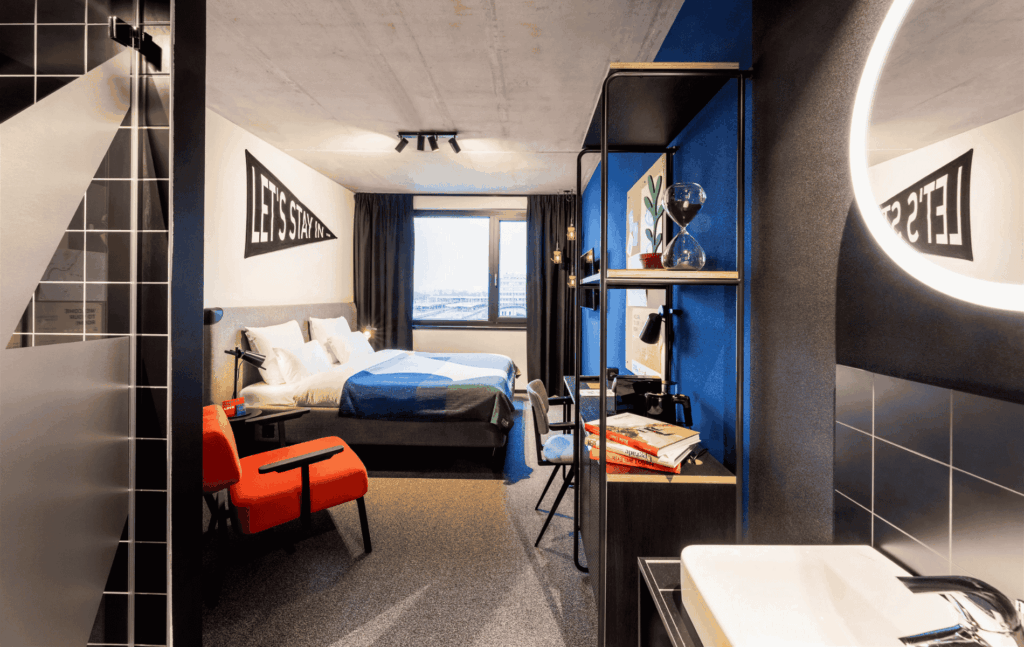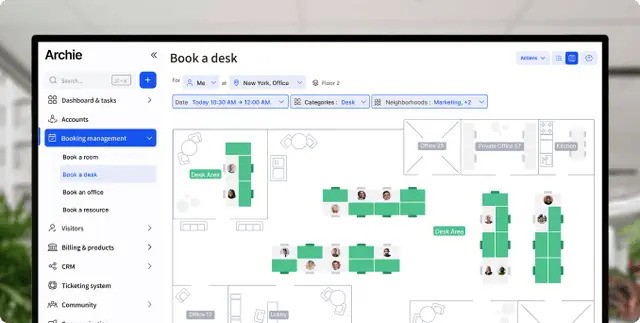With more people working remotely after the pandemic, moving around freely, and looking for meaningful connections, coworking and coliving have been on the rise — and for good reason.
Are these concepts still as popular as a few years back, though? Let’s find out.
Coworking and coliving explained
What is the difference between coworking and coliving?
Coworking spaces are shared workspaces where freelancers, remote workers, and small teams can rent a desk, a meeting room, or just a quiet place to work. They usually offer fast Wi-Fi, comfy chairs, great coffee, and the chance to meet other professionals.
Coliving spaces, on the other hand, are all about how we live. Think of it as a modern version of shared housing — you get your own private room (often with your own bathroom), and share kitchens, lounges, or gyms with others. But it’s not just about sharing a roof, it’s about creating a sense of community as well.
When you combine coliving and coworking, you get a space where you can live, work, and connect with others, all in one place.
The current state of coworking and coliving
Coworking and coliving are growing fastest in busy, expensive cities like London, Berlin, New York, Singapore, and Dubai, where people are looking for more affordable and social ways to live. And it’s not just a passing phase — the global coliving market was valued at $7.7 billion in 2024 and is expected to more than quadruple by 2034. That’s a huge jump, and it shows just how much demand there is.
Industry research shows that coworking is also booming. Thanks to the rise in remote and hybrid work, the global market is expected to hit $25.1 billion in 2025.
What’s making these spaces so popular isn’t just the setup — it’s how smart and community-focused they’ve become:
- Coworking zones, strong Wi-Fi, and private Zoom rooms are standard now, making it easy to stay productive no matter where you are.
- Events, group dinners, yoga sessions, and workshops help people connect beyond just sharing a kitchen or desk. In fact, studies show that strong social bonds are one of the top reasons people stay in coliving spaces.
- Apps make everything simpler — from booking a room or desk, to paying rent, or signing up for the next rooftop BBQ.
- And it’s not just for twenty-something travelers anymore. Some coliving spaces are now designed for students, older adults, interns, and even company employees on short-term assignments.
At the same time, coliving and coworking spaces aren’t making as many headlines as they used to. Some well-known names like Common, WeLive, and Roam have either shut down or slowed operations. This might be partially because of more companies asking people to return to the office full-time or deciding to go hybrid.
But the story isn’t all doom and gloom — some coliving and coworking companies are still going strong and even expanding:
The best examples of coworking and coliving spaces
Outsite
Outsite is a great example of how coliving and coworking can come together to support the remote lifestyle. It’s a global network designed for digital nomads, freelancers, and remote workers who want the freedom to travel without losing their work routine or sense of community. With around 50 locations worldwide, from sunny Bali to creative Barcelona and colorful Marrakech, you can book a room for a few nights or stay for a few months. Each space includes places to sleep, work, and connect with others, making it easy to feel at home no matter where you are.

The Social Hub
The Social Hub (formerly The Student Hotel) is taking coliving and coworking to a whole new level in Europe. As of 2025, it has 21 locations across 19 cities, including newly opened spots in Florence, Rome, and Porto. These hubs aren’t just places to stay — they mix hotel rooms, student housing, coworking areas, and vibrant community spaces all in one.

Why people love coworking & coliving spaces
People are drawn to coworking and coliving spaces because they offer a strong sense of community, making it easy to meet others and feel at home while traveling or working remotely. These spaces also stand out for their comfortable, well-designed work environments, convenient locations close to essentials (and sometimes the beach), and helpful extras like SIM cards or airport pickups.
Some digital nomads even choose their travel destinations based on the quality of coworking and coliving options, showing just how central these spaces have become to their lifestyle. But, of course, these spaces also have some downsides.
Pros and cons of coliving
One of the biggest perks of coliving is the built-in community. You’re surrounded by people who often have similar lifestyles — like freelancers, remote workers, or students — so it’s easy to make friends or join in on group dinners and events. In fact, a UK survey by Knight Frank found that 92% of coliving residents would recommend the experience to others.
Another reason people love coliving is the flexibility. You can usually stay for just a few weeks or several months, and the rent typically includes everything — Wi-Fi, furniture, utilities, and sometimes even cleaning or social events. This makes budgeting simple and stress-free.
Coliving can also be more affordable, especially in big cities where solo apartments are pricey. In some places, it’s 15–20% cheaper than renting a place on your own. Plus, it’s a great way to network and be social — perfect if you’re new in town or working remotely and want more daily interaction.
But coliving isn’t for everyone. Even though you usually get your own room (and sometimes your own bathroom), you’ll still be sharing kitchens, lounges, and other spaces. That means less privacy, which can be tough if you’re used to living alone.
It also takes a little adjustment to get used to shared routines and rules, like being mindful of quiet hours or cleaning up after yourself in shared areas. And since every coliving space has its own vibe, it might take a bit of trial and error to find one that really feels like home.
Pros of coliving | Cons of coliving |
|---|---|
Built-in community and social life | Less privacy in shared spaces |
Flexible stays with all-inclusive pricing | Adjusting to shared routines and house rules |
Often cheaper than renting solo in big cities | Not every space has the right community fit |
Ideal for remote workers, freelancers, and newcomers to a city |
Pros and cons of coworking
Coworking spaces are super flexible. You can rent a desk or private office by the day, week, or month, no long leases or setting up your own office required. This makes them a great option for freelancers, startups, and hybrid teams who want a professional setup without the hassle.
They also offer inspiring work environments. With natural light, thoughtful design, and a buzzing atmosphere, coworking spaces help people feel focused and energized. A global survey showed that 84–89% of coworkers said they felt more motivated and happy working in these kinds of spaces.
Coworking is also great for meeting people and building your network. Whether you’re chatting over coffee or joining a hosted event, it’s a natural way to connect with others. Many spaces offer talks, workshops, and community gatherings. Plus, there are often nice perks like free snacks, wellness classes, or phone booths for calls.
That said, coworking isn’t perfect. Some spaces can get noisy or crowded, especially if they’re open-plan. And while some memberships are affordable, extra fees for meeting rooms or premium perks can add up if you go often.
Also, not every coworking space suits every type of work. If your job involves lots of calls, highly focused work, or sensitive information, it’s important to check out a few options to see what setup works best for your needs.
Pros of coworking | Cons of coworking |
|---|---|
No long-term lease required | Can get noisy or crowded |
Inspiring, well-designed work environments | Costs can add up with extras like meeting rooms |
Great for networking and meeting new people | Not ideal for all types of work (e.g. frequent calls, sensitive tasks) |
Includes perks like coffee, events, and wellness spaces |
What does this all mean for space operators
If you’re a space operator or a destination manager, this growing interest in coworking and coliving means a big opportunity to offer more than just a place to sit or sleep — it’s about creating a full experience. People want flexible, comfortable spaces where they can work, live, and connect with others. If you build a strong sense of community, keep things convenient, and design your space with care, you’ll attract remote workers, digital nomads, and modern travelers looking for something more than a basic rental. Are you ready for it?

Berenika Teter
Archie's Content Manager, fueled by filter coffee and a love for remote work. When she’s not writing about coworking spaces and hybrid workplaces, you can probably find her exploring one.


















![The Latest Coworking Statistics & Industry Trends [2026] A cozy coworking space with wooden walls, warm lighting, and a large map of South America.](https://archieapp.co/blog/wp-content/uploads/2025/08/Latest-coworking-statistics-cover-image-400x400.jpg)

![How To Start a Coworking Space: Costs and Plan [2026 Guide] A modern coworking space with white desks, ergonomic chairs, and laptops.](https://archieapp.co/blog/wp-content/uploads/2023/11/Screen-Shot-2023-11-30-at-9.33.09-AM-400x400.png)
